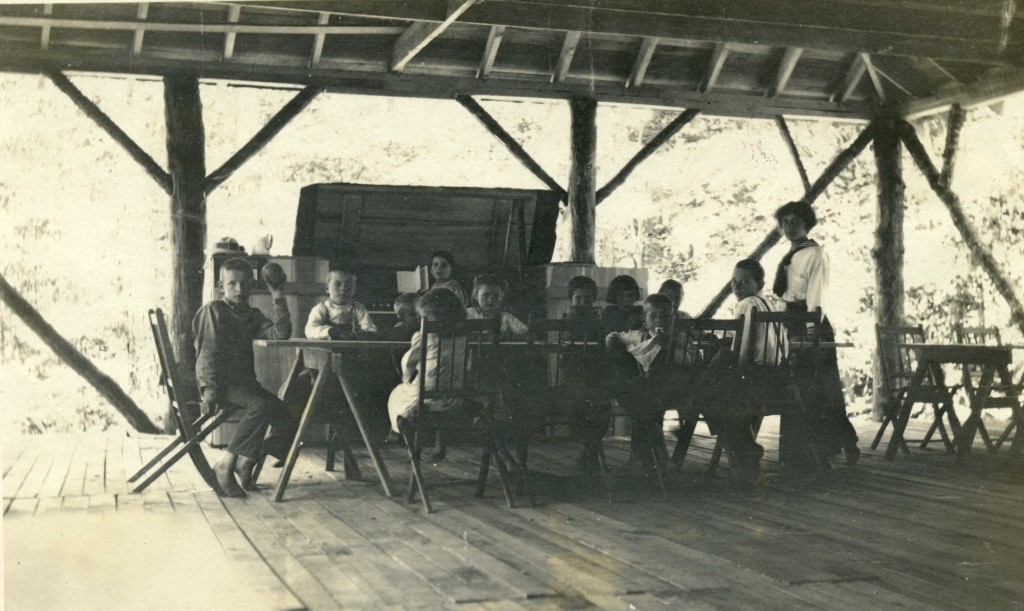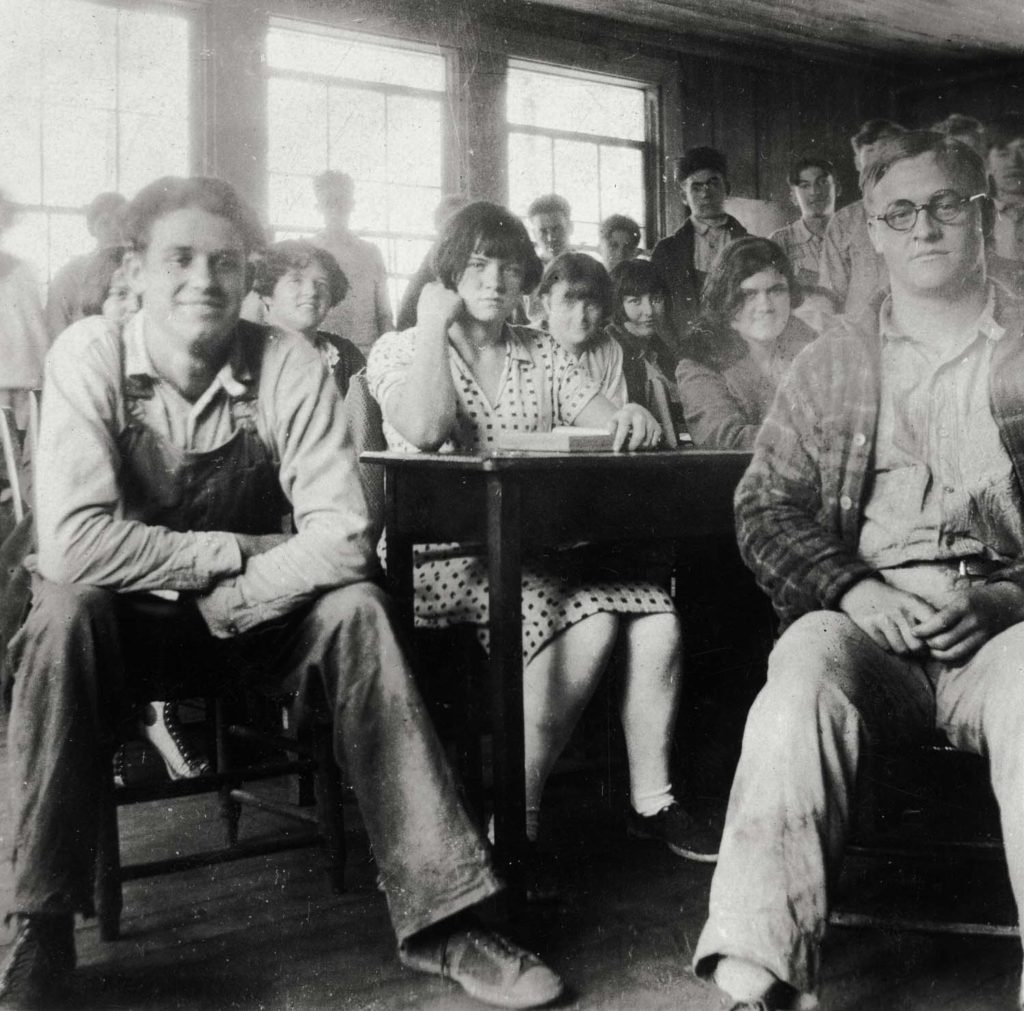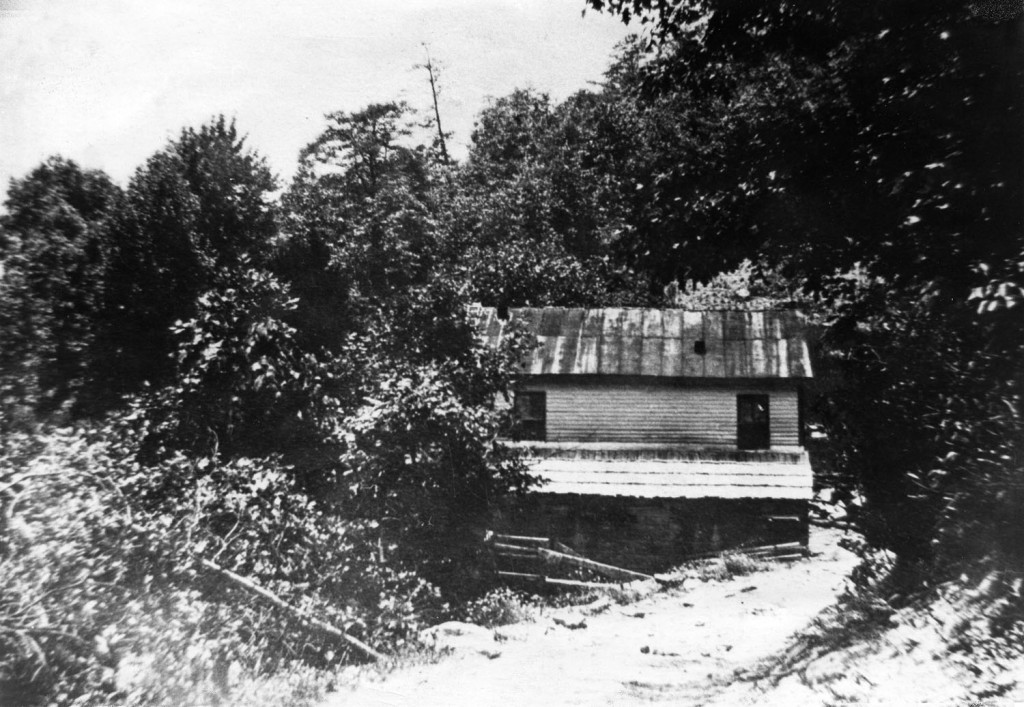Pine Mountain Settlement School
Series 09: Staff/Personnel
Series 03: Histories
Series 13: Education
WELLS RECORD 10 PMSS Academic 1913-1928
Evelyn K. Wells‘ Record 10 PMSS Academic 1913-1928 describes educational activity at Pine Mountain Settlement School from 1913 until 1928.
TAGS: Evelyn K. Wells : Pine Mountain Settlement School ; Harlan County, Kentucky ; Academics ; education ; classes ; industrial education ; Katherine Pettit ; Ethel de Long Zande ; nursing ; House in the Woods ; Masonic Lodge ; academics ; Mary Sinclair Burkham School House ; Nora Howard ; Brit Wilder ; Virgil Smith ; Howard Burdine ; Charles Cornett ;

House in the Woods pavilion with class in session in the early days, c. 1913. [II_2_early_days_123a.jpg]

Mary Sinclair Burkham School House I. [II_12-02_burkham_0427c.jpg]

Schoolroom and students. Brit Wilder to far right, front. Katherine Pettit Album I. [pettit_41_005.jpg]

The Lodge and Store up Isaac’s Creek. First location of school rooms for Pine Mountain. Selected Exhibit.[misc_exhibit_023.jpg]
In 1925 the first booklet of information for parents and children was issued, a great step for us. We were surprised to learn how few schools of Pine Mountain’s age and character had a printed leaflet for parents and children. the booklet did much to crystallize the requirements and standards of the school.
The booklet has been Pine Mountain’s only attempt to standardize. Its ideal has been to open the way for the children to offer them intellectual food that was real mountain fare to fit them for life in a locality that was rapidly changing rather than to fit them into a school system by conforming to what other schools were doing. Much of our work has been of an individual, emergency nature, and you will often find among our graduates young people who do not fall in line with eighth graders and high school students from other schools. With the improvement of schools all through the south, there has been a growing tendency towards standardization, which we have tried to avoid because we felt its deadening effects. Pine Mountain, at the sacrifice of not being accredited, has stayed free.
It has been hard to teach a school so far away from the source of supply of good progressive teachers, and we have suffered from the comings and goings of good teachers who could not afford to work at Pine Mountain, or could not manage the conditions We have lost many who put in a couple of years of solid work with our children, and really took hold of their minds. We have sought the progressively minded and trained, but we have valued the work of experienced teachers who knew how to drill the children in the old ways.
The first use of Antioch [Exchange] students by shifts was in 1925, and since then we have had one and sometimes two pairs of them working cooperatively, most of them particularly successful and a distinct addition to our staff, bringing us in contact with that remarkably interesting college and its new ideas, and contributing to our own morale.
Pine Mountain has run the gamut of intelligence tests, like the rest of the world, but until very recently there have been none really suited to our children with their different experience and vocabulary. The best information on the subject seems to have proved that the Pine Mountain child, while far from lacking in mentality, is not intellectual, making a better craftsman than student; and that our best service must be available for the young person whose mind is the adjunct of his hands and not for development per se. Our young people go on to more advanced schools, but few of them go to college. Nursing, farming marriage work in shops claim most of them. Even the teachers are not the “born” variety and soon marry.
TABLE SHOWING STUDENTS AT PINE MOUNTAIN
1913- 1928
| YEAR | TOTAL FOR YEAR |
CAPACITY | TURNOVER | FROM COUNTRY |
FROM TOWN |
GRAD. 8TH GRADE |
GRADS. FROM HIGH SCHOOL |
| 1913 | 4 | 2 | 4 | ||||
| 1914 | 28 | 33 | 6 | 21 | 7 | ||
| 1915 | 77 | 50 | 26 | 50 | 27 | ||
| 1916 | 93 | 70 | 27 | 71 | 22 | ||
| 1917 | 100 | 70 | 36 | 71 | 29 | ||
| 1918 | 102 | 74 | 30 | 73 | 29 | ||
| 1919 | 103 | 85 | 42 | 72 | 31 | 11 | |
| 1920 | 92 | 94 | 44 | 64 | 28 | 7 | |
| 1921 | 138 | 94 | 37 | 81 | 57 | 8 | |
| 1922 | 105 | 94 | 19 | 74 | 31 | 9 | |
| 1923 | 108 | 100 | 37 | 64 | 42 | 10 | 2 |
| 1924 | 100 | 12 | |||||
| 1925 | 137 | 100 | 40 | 76 | 61 | 7 | 2 |
| 1926 | 138 | 100 | 59 | 42 | 89 | 16 | 4 |
| 1927 | 138 | 100 | 63 | 62 | 77 | 18 | |
The figures for “turn-over” include all students leaving during or at the end of any year for any reason whatever.
Full figures for the year 1924 were not available.
Total number of students who have passed through the school 666+ those in 1924.
Total graduates for eighth grade 94.
Total High School graduates 6.
1924 Graduates, Kitty Ritchie, who has since completed her college course at Berea. Elva Lewis, who married during her high school course and completed it after marriage.
1926 Graduates, Elsie Creech, now in college at Berea. Becky May Huff, who specialized in weaving first at Berea and is now teaching weaving at Olive Hill.
1927 Graduates, Nora Howard, now at Berea. Virgil Smith, now at Berea. Charles Cornett, no further study. Howard Burdine, No further study. [In Miss Pettit’s writing on copy] — “Now at Berea, June 1935.”
SEE:
EVELYN K. WELLS GUIDE TO ADMINISTRATIVE CORRESPONDENCE
EVELYN K. WELLS, GUIDE to EXCERPTS FROM LETTERS HOME 1915-1923
EVELYN K. WELLS RECORD OF PINE MOUNTAIN SETTLEMENT SCHOOL 1913-1928 [INDEX]
[22 sections of early in-depth history of Pine Mountain Settlement School gathered by Evelyn K. Wells from 1913 to 1928]
2. Introductory
3. Year by Year [Construction, Workers, Gifts, Children, Events, etc.]
10. Academic
11. Health
12. Extension Work
15. Athletics
16. Dramatics
17. Some Contributions to the Outside World
18. Religious Life
19. The Road
22. List of Workers
EVELYN K. WELLS PUBLICATIONS
Wells, Evelyn K. The Ballad Tree: A Study of British and American Ballads, Their Folklore, Verse and Music, Together with Sixty Traditional Ballads and Their Tunes. New York: Ronald Press, 1950. Print.
[See Bibliography below for a listing of additional publications.]
EVELYN K. WELLS “A Little True Blue American,” Over Sea and Land: Our Southern Mountains, November 1920, p. 140.
EVELYN K. WELLS TALKS
EVELYN K. WELLS PMSS Harvard University talk, on Folk Music. July 21, 1955

